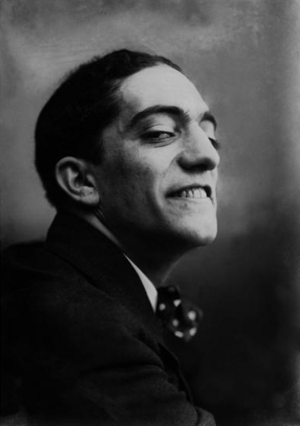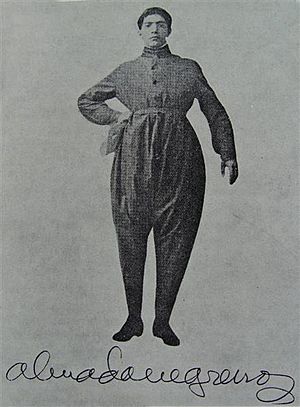Almada Negreiros facts for kids
Quick facts for kids
Almada Negreiros
|
|
|---|---|

Almada Negreiros, photographed by Vitoriano Braga
|
|
| Born | 7 April 1893 Roça Saudade, Trindade, São Tomé |
| Died | 15 July 1970 (aged 77) Hospital de São Luís dos Franceses, Lisbon |
| Occupation | Painter, writer |
| Genre | novel, play, poem, essays and pamphletary manifests |
| Literary movement | Futurism |
| Spouse | Sarah Afonso |
José Sobral de Almada Negreiros (born April 7, 1893 – died June 15, 1970) was a very important Portuguese artist. He was born in a place called São Tomé and Príncipe, which was a Portuguese colony back then. His father was Portuguese, and his mother was from São Tomé.
Almada Negreiros was super talented! He didn't just paint and write. He also created dances for ballets. Plus, he worked with tapestry, engraving, murals, caricatures, mosaics, azulejo (Portuguese tiles), and stained glass. He was truly a master of many arts!
Contents
His Amazing Life and Art
Almada Negreiros's mother passed away when he was very young, in 1896. In 1900, he went to a Jesuit school in Lisbon. When a big change happened in Portugal in October 1910, the school closed. He then went to another school in Lisbon called Escola Internacional.
In 1913, he had his first art show, displaying 90 drawings. A few years later, in 1915, he joined famous writers like Fernando Pessoa and Mário de Sá-Carneiro. They published poems and stories in an art magazine called Orpheu. This magazine was very important because it brought a new style of art and writing, called Modernism, to Portugal.
In that same year, Almada Negreiros wrote a famous and funny text called Manifesto Anti-Dantas e por extenso. It was a playful attack on older, more traditional artists and their ideas. Also in 1915, he designed a ballet called O Sonho da Rosa.
In 1917, Almada Negreiros wanted to show the Portuguese people a new art style called Futurism. He worked with another artist, Santa-Rita Pintor, to publish a magazine called Portugal Futurista. In it, he wrote a text called Ultimatum Futurista, às gerações portuguezas do século XX (which means "Futurist ultimatum to the Portuguese generations of the 20th century"). He even gave a talk, the Sessão Futurista, where he wore a flight suit!
Between 1918 and 1920, Almada lived in Paris, France. To earn money, he worked as a dancer and in a factory. He came back to Lisbon in 1920. In 1925, he painted two artworks for a very famous café in Lisbon called A Brasileira. In 1927, he moved to Madrid, Spain, and wrote for different Spanish magazines.
When he returned to Portugal, he became a key artist in modern Portuguese art. His work was inspired by Cubism and especially by Futurism. During the time of António de Oliveira Salazar's government, which was very strict, Almada's role was a bit tricky. He sometimes created public art or posters for the government. But he also bravely criticized Portuguese society.
In 1934, he married another painter, Sarah Afonso. They settled in Portugal for good. He kept being an "artistic agitator," meaning he kept pushing for new ideas in a society that was not very open to change. In 1934, they had their only son, José Afonso de Almada Negreiros.
He also sometimes acted and danced. He believed that all kinds of art are connected.
His Art: Painting and More!
Almada Negreiros often called himself a Futurist artist. He was inspired by artists like Filippo Tommaso Marinetti. But his art style was very broad and unique. It didn't easily fit into just one category. Besides modern ideas, his works also had rich patterns and sometimes used geometric shapes.
His public art often had a message. For example, his mural "Gare Maritima de Alcantara" shows this. Many of his paintings and drawings showed everyday people doing normal things. This was common in art that wanted to show social issues. Besides painting, he also designed tapestries, prints, and sets for theater and ballet.
His Books and Writings
A big part of Almada Negreiros's art was his writing. He wrote novels, poems, plays, essays, and strong statements called manifestos. These were published in books, magazines, newspapers, and even small, cheap booklets.
In his novels and plays, he wrote about people's daily lives. He often added a sense of the strange or silly, which can make you think of writers like Eugène Ionesco. His writing was very connected to his visual art. It often had visual and "geometric" descriptions.
His manifestos were very bold. For example, "Manifesto Anti-Dantas" was a funny and strong text against Júlio Dantas, a big name in art and culture during Salazar's time. This manifesto was a symbol against being average and just following the crowd. He also wrote essays about color theory, old Portuguese paintings, and geometry. He gave many talks about cultural topics too.
Literary Works
- O Moinho (1913)
- Os Outros (1914)
- 23, 2º Andar (1914)
- Frizos, published in Orpheu vol. 1, pp. 51–59 (prose) (1915)
- A Cena do Ódio (poetry) (1915)
- Manifesto Anti-Dantas e por extenso (1915)
- Litoral (1915)
- A Engomadeira (novel) (1915, published in 1917)
- Ultimatum Futurista, às gerações portuguezas do século XX (conference) (1917)
- K4, O Quadrado Azul (novel) (1917)
- Saltimbancos Contrastes Simultâneos (1917)
- A Invenção do Corpo (conference) (1921)
- O Cágado (1921)
- A Invenção do Dia Claro (1921)
- Histoire du Portugal par coeur (1922)
- Pierrot e Arlequim (theatre) (1924)
- Nome de Guerra (novel) (1925, published in 1938)
- A Questão dos Painéis (essay) (1926)
- El uno, tragedia de la unidad (composed of Deseja-se Mulher and S.O.S) (1928)
- Portugal, Direcção Única (1932)
- Elogio da Ingenuidade ou as Desventuras da Esperteza Saloia (1936)
- Mito-Alegoría-Símbolo, Monólogo autodidacta na oficina da pintura (1948)
See also
 In Spanish: José de Almada Negreiros para niños
In Spanish: José de Almada Negreiros para niños


